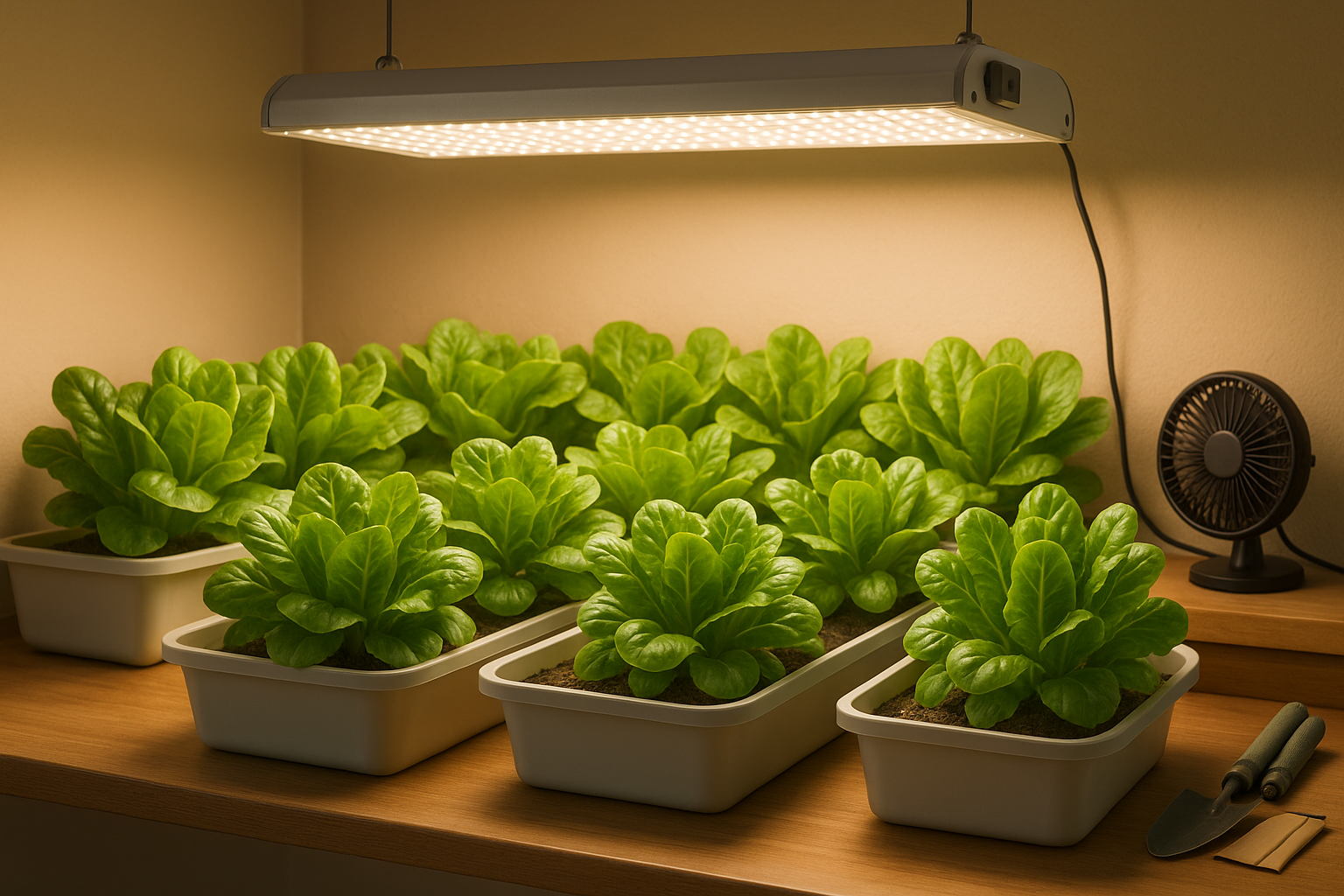Understanding Lettuce Light Needs for Indoor Growing
Lettuce is a cool-season crop that thrives on steady, moderate light to produce crisp leaves. Understanding its specific light needs is the foundation for indoor gardening success. While outdoor lettuce relies on natural sunlight—ideally six to eight hours of gentle, indirect light per day—indoor growers must recreate this environment to avoid disappointing results like weak stems or bitter, stressed leaves.
Modern LED grow lights are a top choice for home growers because they provide both the intensity and balanced spectrum required for healthy lettuce. Unlike older fluorescent bulbs or low-output LEDs, full-spectrum LED lights mimic natural sunlight by delivering the wavelengths plants need most, especially in the Photosynthetically Active Radiation (PAR) range of 400–700 nanometers.
This is crucial, as lettuce photosynthesizes most efficiently when exposed to blue and red light within this range, encouraging robust, compact heads and sweet flavor. Miss the mark, though, and you’ll quickly notice problems: too little light leads to “leggy” growth, where stems stretch thin searching for more illumination, while too much intense light—especially if the fixture is too close or not designed for plants—can scorch leaves, cause stress, or result in an unpalatable bitterness.
A helpful tip: invest in a timer to provide 12–16 hours of consistent lighting each day, and keep lights 8–12 inches above your crop to avoid excess heat while ensuring even coverage. Monitoring light levels with a PAR meter, if possible, can help you perfect your setup and consistently harvest vibrant, flavorful lettuce from your indoor garden.
Choosing the Right LED Grow Lights for Lettuce
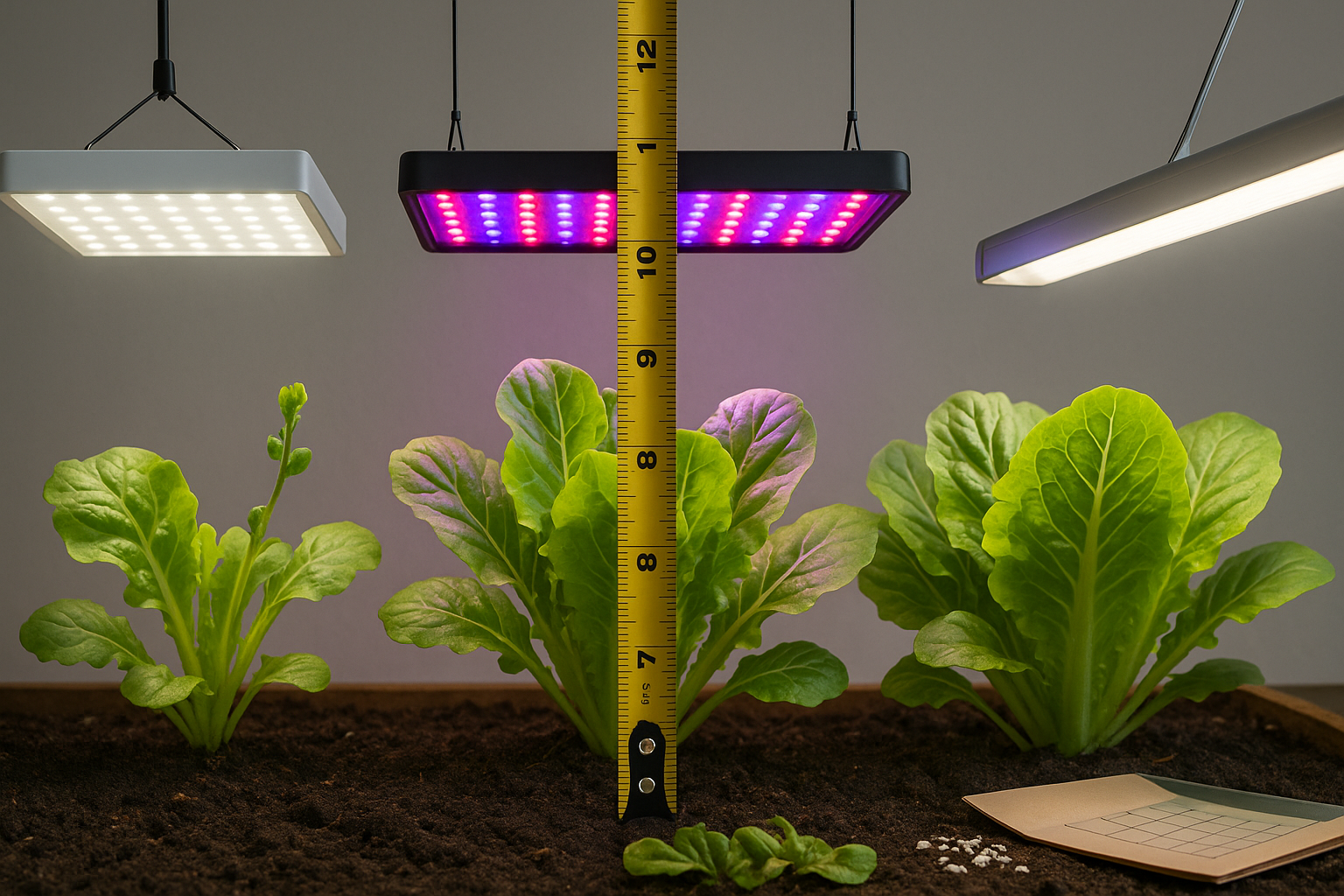
When it comes to choosing LED grow lights for lettuce, it’s important to understand the different types and which best support leafy growth. Full-spectrum LEDs offer a balanced light that closely mimics natural sunlight, making them ideal for robust lettuce production throughout all growth stages. White LEDs are versatile and easy on the eyes but may not deliver the targeted light wavelengths lettuce loves most. Red/blue LEDs, sometimes known as “blurple” lights, specifically cater to photosynthesis but can make plants harder to inspect due to their unusual coloring.
For healthy, vigorous lettuce, full-spectrum lights are generally the top pick because they provide everything your plants need under one fixture. When assessing wattage and coverage area, a good rule of thumb for small home setups is 30 to 40 watts per square foot, with a single 100-watt LED covering about 2’x2’ of lettuce. Lettuce thrives under moderate-to-high light intensity: aim for a PPFD (photosynthetic photon flux density) of 150–300 µmol/m²/s and a daily light integral (DLI) in the range of 12–17 mol/m²/day for optimal growth.
Opt for fixtures with adjustable height so you can keep the lights 8–12 inches above your plants and move them as lettuce matures, preventing leaf burn. Built-in timers add convenience and consistency — a big plus for busy growers. To save on electricity and upfront costs, choose LEDs with high energy efficiency (look for output over 2.0 µmol/J), and consider reputable but affordable brands like Spider Farmer, Mars Hydro, or ViparSpectra, which offer reliable lights suited for home lettuce gardens.
Setting Up Your Indoor Lettuce Growing System
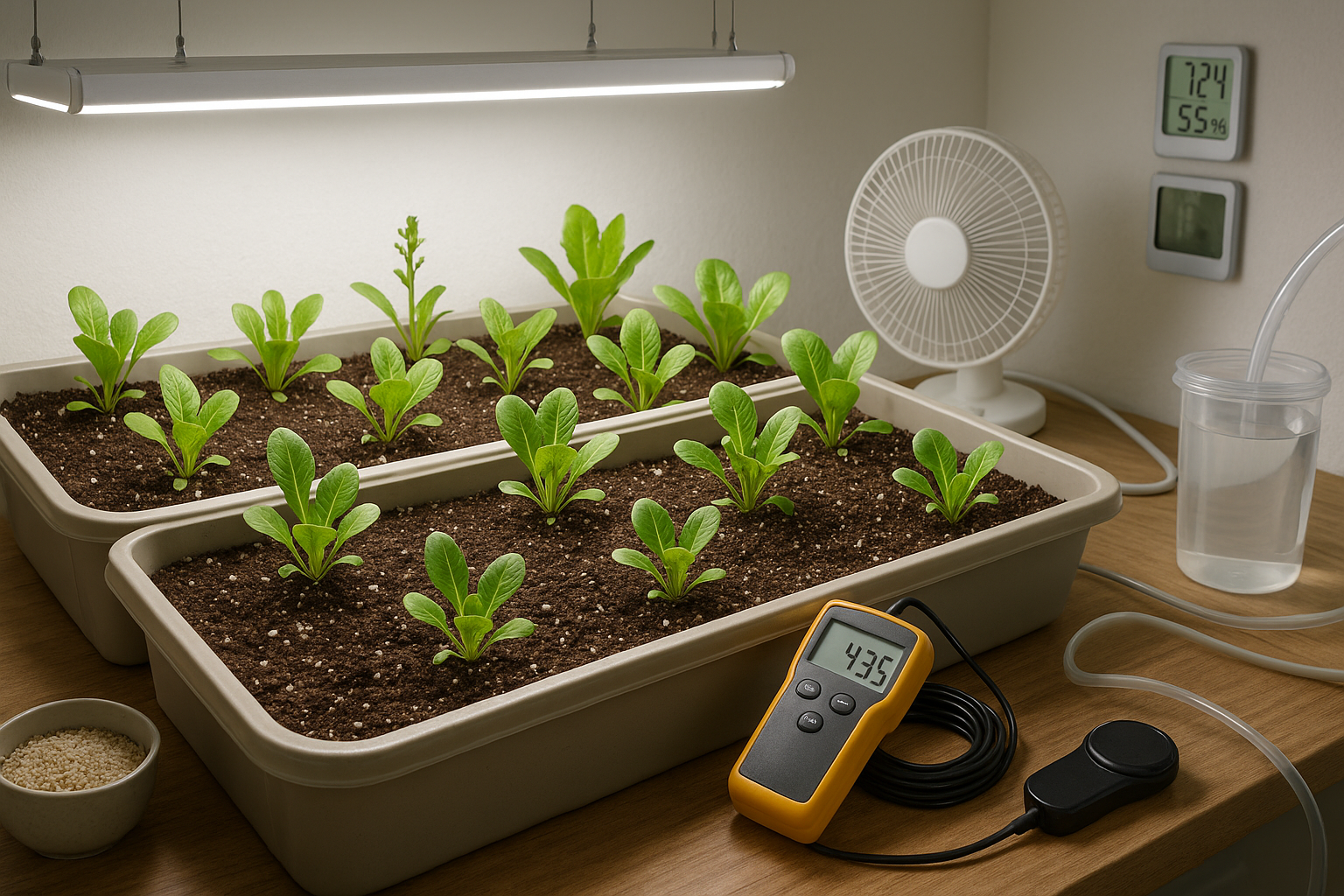
Starting your indoor lettuce garden is simple with the right setup. Begin by choosing your container: wide, shallow planters or seed-starting trays work well since lettuce doesn’t need deep soil. For convenience, plastic or fabric pots with drainage holes are ideal to prevent soggy roots.
Use a light, airy potting mix formulated for vegetables—one that contains peat or coco coir for moisture retention, plus perlite or vermiculite for drainage. If you want to skip soil, hydroponic methods like the Kratky or deep water culture systems are great for beginners. These support rapid lettuce growth under LED lights and require only a simple nutrient solution.
When planting, space seeds or seedlings about 4–6 inches apart to give leaves room to expand. This reduces the risk of disease and encourages healthy heads.
Hang LED grow lights 12–18 inches above the plants, adjusting as they grow. You want the leaves to be brightly lit but not hot to the touch, as heat can cause burns. Use a timer to provide 12–16 hours of light daily; a consistent schedule helps prevent spindly (leggy) plants.
Maintain daytime temperatures around 65–70°F and nighttime temperatures no lower than 55°F for optimal leaf growth. Aim for 40–60% humidity. Use a small fan for ventilation to strengthen plants and deter mold.
With attention to these details, you’ll have crisp, flavorful lettuce ready to harvest in just a few weeks—perfect for any indoor space!
Best Practices for Growing Lettuce Under LEDs
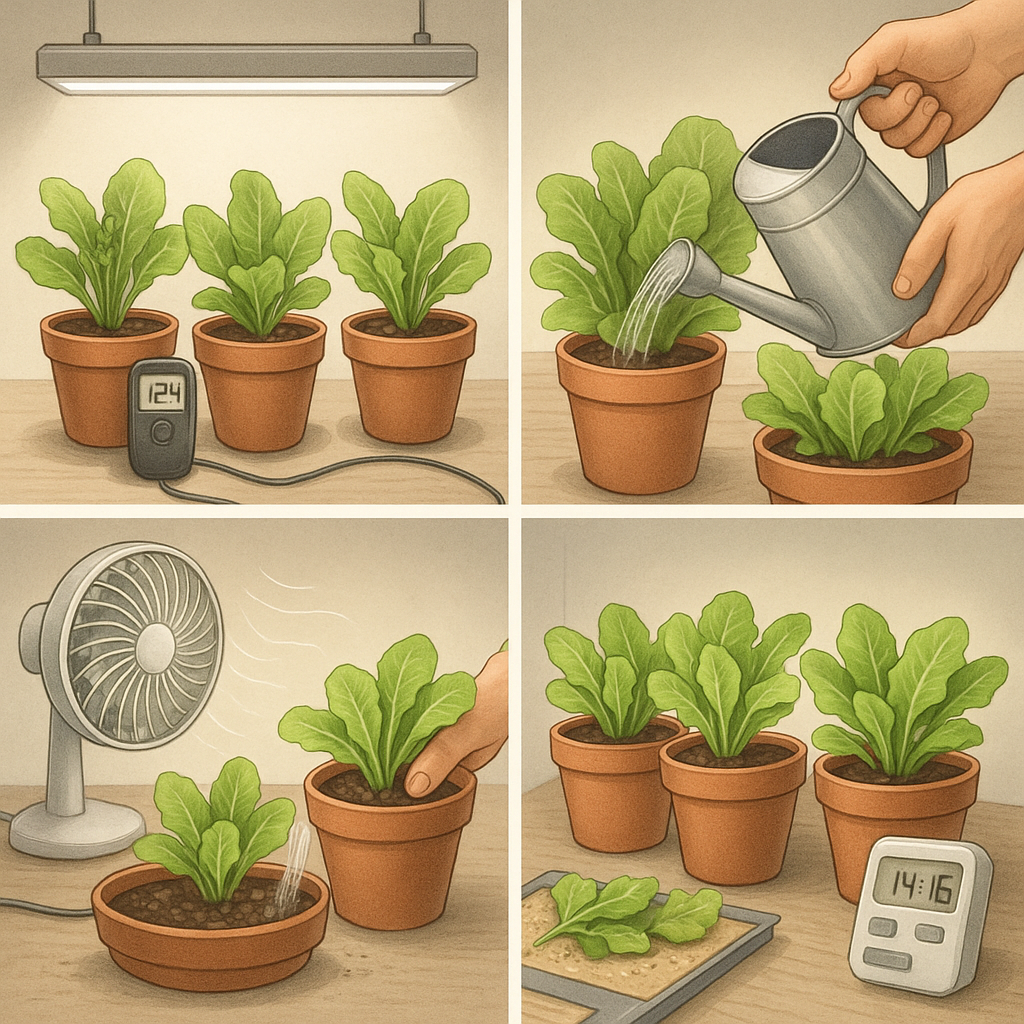
Growing lettuce under LED lights can be both rewarding and simple when you follow a few best practices. Start seeds in a moist, seed-starting mix under your LEDs, keeping light intensity moderate (about 14–16 hours daily) until seedlings emerge with healthy, green leaves. Thin seedlings to avoid overcrowding, which can hinder airflow and promote fungal problems.
Once they have four true leaves, transplant them into larger containers or your hydroponic system, ensuring each plant has enough space to expand. During the vegetative stage, increase LED intensity to mimic longer daylight and encourage lush, compact growth. However, avoid placing lights too close—6 to 12 inches above the canopy is ideal for most setups.
Water consistently but not excessively; lettuce roots dislike soggy soil. Check soil or growing medium moisture daily, and water when the top inch feels dry. Fertilize every one to two weeks with a balanced, water-soluble fertilizer, especially if you notice slowed growth or pale leaves.
Maintain airflow with a small fan to reduce humidity and prevent disease—healthy air circulation also strengthens lettuce stems. If you spot yellow leaves, you may need to increase light intensity or check for overwatering, as both can cause similar symptoms.
Premature bolting—when your lettuce starts to flower early—is often triggered by long hours of intense light or too much heat. If this occurs, try decreasing light duration to 10–12 hours or lowering temperatures.
Use a light meter or smartphone app to monitor PAR (photosynthetically active radiation) and adjust your LED panel’s height or dimming settings as plants grow, ensuring even coverage.
Harvest outer leaves when they reach 3–4 inches, or cut entire heads once mature. Keep your LED schedule consistent to ensure a steady supply of tender, flavorful lettuce year-round.
Harvesting and Maintaining Your Lettuce Crop
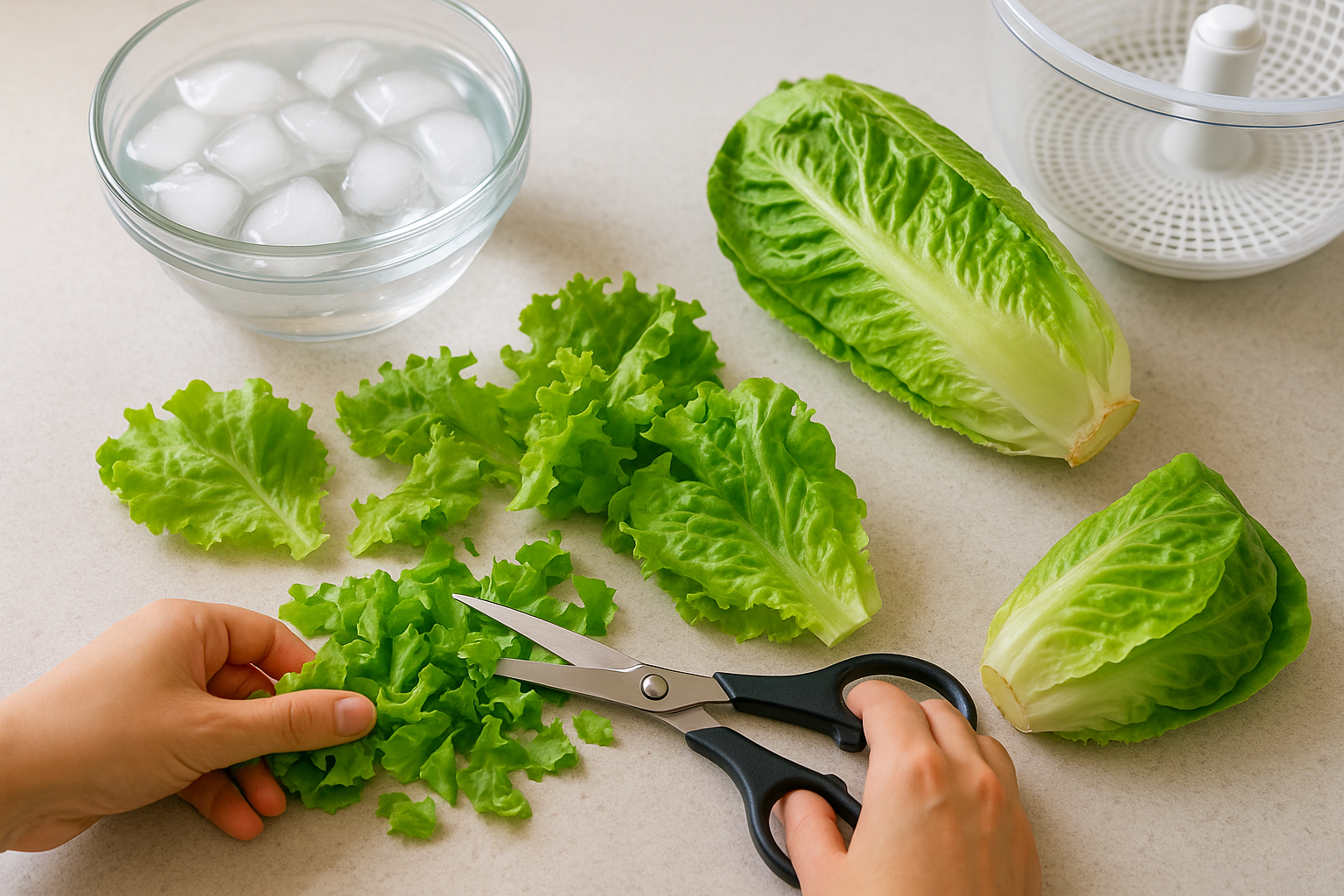
Harvesting lettuce at the right time is key to both flavor and yield, and it varies depending on the type you’re growing. Leaf lettuces can be harvested once the leaves reach about four inches long—simply snip the outer leaves with clean scissors, leaving the center intact for regrowth. For head lettuces like romaine or butterhead, wait until they form a firm, full head and cut them at the base.
To encourage ongoing harvests, try succession planting: sow a new batch of seeds every two to three weeks so you’ll always have young, tender lettuce coming up as older plants are picked. Staggered seeding—planting small groups of seeds a week apart—also helps extend your harvest window and minimizes overwhelming gluts.
After cutting, gently wash lettuce leaves in a bowl of cold water to remove dirt and bugs, then pat them dry or use a salad spinner. Store your leaves in a breathable container or perforated bag in the crisper drawer, where they’ll stay fresh for up to ten days. If you notice any wilting, revive leaves by soaking them in ice water for a few minutes.
Try to use outer leaves or slightly damaged ones first in smoothies or soups to minimize waste. Finally, keep an eye on your lettuce bed: remove any yellowing leaves, watch for pests, and water consistently to keep your plants healthy and productive for weeks on end.
Frequently Asked Questions About Growing Lettuce With LEDs
Many beginners wonder if growing lettuce under LEDs affects its taste or nutritional value. Research and grower feedback show that, when used correctly, LEDs can actually enhance lettuce flavor and tenderness since you control the light spectrum and intensity—reds and blues are key for leafy greens.
Another common question is about how close LEDs should be to your lettuce. Too far and plants get leggy; too close and you risk leaf burn. The sweet spot is usually 6-12 inches above the canopy, depending on your light’s wattage and design. Try starting at 10 inches and adjust based on leaf warmth and growth—if leaves feel hot, raise the light.
New growers also ask about LED compatibility and troubleshooting; most modern LEDs work well for lettuce, but make sure yours is labeled “full spectrum.” If you see pale leaves or stunted growth, you may need to increase light time or intensity.
LEDs use less electricity than traditional grow lights, so they’re energy-efficient, but always check your setup for proper airflow to prevent overheating. Safety-wise, ensure all cords and lights are kept away from water sources to avoid any electrical hazards—using LED grow lights with waterproof ratings is wise.
By following these tips, you’ll not only keep your lettuce healthy but can also maximize yield and enjoy crisp, flavorful homegrown greens year-round.
